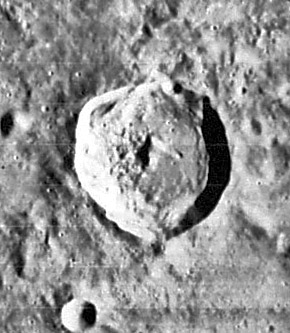Agrippa
Contents
Agrippa
|
Lat: 4.08°N, Long: 10.47°E, Diam: 43.75 km, Depth: 3 km, Rükl: 34, Eratosthenian |
Images
LPOD Photo Gallery Lunar Orbiter Images Apollo Images
- Although there seems to be no orbital Hasselblad Apollo-photographs of Agrippa itself (close ups), Apollo 16's Metric/Mapping Fairchild camera made a series of interesting oblique northward-looking photographs of the region south of Agrippa, with Agrippa itself near (or "below") the curved horizon. AS16-M-0836 is one of those photographs, with Agrippa slightly rightward and below the horizon's central part. The crater just below (to the south of) Agrippa is Godin.
- See also Apollo 16's AS16-M-1399, which shows the same view as in the above mentioned AS16-M-0836, but... the sun's higher in the sky.
- Apollo 17's Metric/Mapping Fairchild camera also made a series of oblique photographs which show Agrippa. One of them, AS17-M-1668, shows a southward-looking view with distant Agrippa very near the curved horizon (the central part of the horizon).
- Careful investigation of Apollo 12's orbital Hasselblad photographs reveals a neat oblique (high-sun) look at Agrippa. See: AS12-52-7723 (Agrippa is the large crater near the frame's upper left corner, Lade near the frame's upper right corner, and Godin in between them).
- Research: Danny Caes
Maps
(LAC zone 60D1) LAC map Geologic map LM map AIC map
Description
Elger
(IAU Directions) AGRIPPA.--A ring-plain 28 miles in diameter on the N. of Godin, with a terraced border rising to a height of between 7,000 and 8,000 feet above the floor, which contains a large bright central mountain and two craters on the S. The shape of this formation deviates very considerably from circularity, the N. wall, on which stands a small crater, being almost lineal. On the E., at a distance of a few miles, runs the prominent mountain range, extending northwards nearly up to the W. flank of Julius Caesar, which bounds the W. side of the great Ariadaeus plain. Between this rocky barrier and Agrippa is a very noteworthy enclosure containing much minute detail and a long straight ridge resembling a cleft. A few miles N. of Agrippa stands a small crater; at a point E. of which the Hyginus cleft originates.
Wikipedia
Additional Information
- IAU page: Agrippa
- Data from Kurt Fisher crater depths
- Pike, 1976: 3 km
- Westfall, 2000: 3 km
- Viscardy, 1985: 3.1 km
- Cherrington, 1969: 2.98 km
- Lunar Base Site: One of the early papers describing lunar bases proposed that a site near Agrippa would be ideal.
- Included in ALPO list of bright ray craters.
- Radar bright at both 3.8 cm and 70 cm, implying that it is young (consistent with rays).
- The central peak when measured from the west rises 1.4km, when measured from the east it rises 0.7km Sekiguchi, 1972. - fatastronomer
- Main peak = 1.4 km (1445 m approx., - calculated) from shadows in LO Frame 4097 H1 using LTVT) - JohnMoore2
- Near the two fine craters Agrippa and Godin, Schroter once saw for a short time on the dark side, a minute point of light. Source: T.W.Webb's Celestial Objects for Common Telescopes (Volume 1: The Solar System), page 118.- DannyCaes May 21, 2012
Nomenclature
- The name Agrippa is from G.B.Riccioli (see page 210 in E.A.Whitaker's Mapping and Naming the Moon).
- Named for Agrippa (unkn-fl. 92 AD), a Greek astronomer. The only thing that is known about him regards an astronomical observation that he made in 92 AD, which is cited by Ptolemy.
- Strange... according to the book Who's Who on the Moon by the twin-brothers Elijah and Josiah Cocks (1995), crater Agrippa was named after a certain Heinrich Cornelius Agrippa von Nettesheim (1486-1535; German writer, chemist, physician). - DannyCaes Apr 29, 2017
LPOD Articles
1872 drawing Walls slumps A Moth Lover's View of the Moon Wall Stories
Bibliography
- Hill, Harold. 1991. A Portfolio of Lunar Drawings., page 4 (the Ariadaeus rille at sunset).
Named Features -- Prev: Rima Agricola -- Next: Airy
